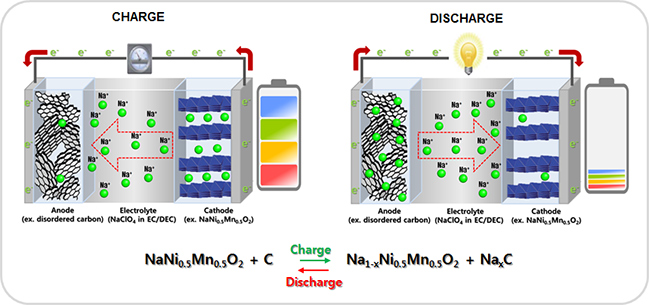Sodium (Na)-ion battery -
- Na-ion battery
-
Sodium-ion battery is a type of rechargeable battery that uses sodium-ions as its charge carriers. The sodium ions move from a disordered carbon (NaxC) structure to a Na1-xNi0.5Mn0.5O2 structure during discharge and the reverse process occurs during charge. This type of battery is in a developmental phase, but may prove to be a cheaper way to store energy than commonly used lithium-ion batteries. Sodium-ion batteries have been gaining increasing attention thanks to the natural abundance and low toxicity of sodium resources. Furthermore, sodium is located just below lithium in the periodic table. Therefore, similar chemical approaches including a synthetic strategy, intercalation/alloying/conversion chemistry, and characterization methods utilized in electrode materials for lithium-ion batteries could be applied to develop electrode materials for sodium-ion batteries. -
 -
- Characteristics
- Higher availability of Na
- The 4th most abundant element in the earth crust
- Inexpensive
- For large scale battery applications
- Lower performance than Li-ion battery
- Higher redox potential (-2.71 V vs. SHE) of Na/Na+
- Larger size (1.02 Å) of Na+ compared to Li+ (0.76 Å)
- Operating temperature
- Na-ion battery operates at ambient temperature
- Na/S, Na/NiCl2 systems operate at elevated temperatures (300-350 °C)
-
- Electrode materials for Na-ion batteries
- Characterization of representative anodes
Characterization of representative anodes | Na metal | Graphite | Disordered
carbon | Na-alloy | Na2Ti3O7 | | Capacity | 1166 mAh g-1 | Not intercalate | ~250 mAh g-1 | >500 mAh g-1 | 178 mAh g-1 | | Potential | Low | - | Low | low | low | | Safety | Very poor | - | Good | Poor | Good | - Characterization of representative cathodes
Characterization of representative anodes | NaCoO2 | NaVPO4F | NaFePO4 | Na0.4MnO2 | NaNi0.5Mn0.5O2 | | Crystalline system | Layered | Layered | Olivine | Layered | Layered | | Specific capacity | ca. 148 mAh g-1 | ca. 120 mAh g-1 | ca. 150 mAh g-1 | ca. 140 mAh g-1 | ca. 185 mAh g-1 | Voltage
(V, Na/Na+) | 3.6 V | 3.5 V | 2.8 V | 2.0 ~ 3.8 V | 2.5 ~ 4.5 V | |
|
|











